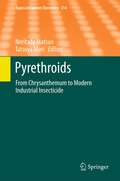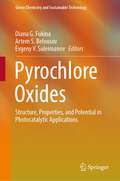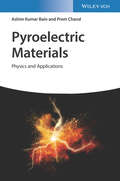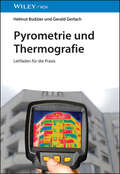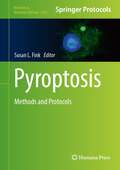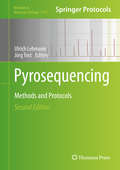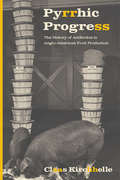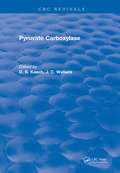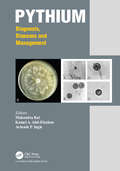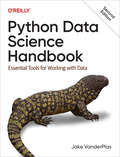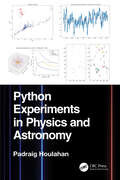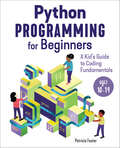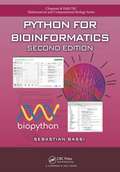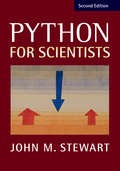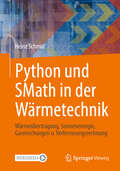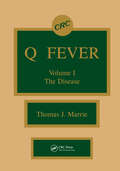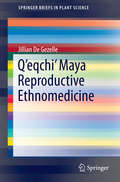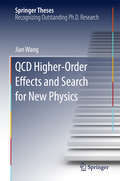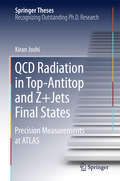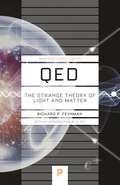- Table View
- List View
Pyrethroids
by Tatsuya Mori Noritada MatsuoProgress and Future of Pyrethroids, by Yoshio Katsuda Pyrethrin Biosynthesis and Its Regulation in Chrysanthemum cinerariaefolium, by Kazuhiko Matsuda Recent Advances of Pyrethroids for Household Use, by Kazuya Ujihara, Tatsuya Mori and Noritada Matsuo The Biological Activity of a Novel Pyrethroid: Metofluthrin, by Masayo Sugano and Takao Ishiwatari Advances in the Mode of Action of Pyrethroids, J. Marshall Clark and Steven B. Symington Mammal Toxicology of Synthetic Pyrethroids, by Ryozo Tsuji, Tomoya Yamada and Satoshi Kawamura Biotransformation and Enzymatic Reactions of Synthetic Pyrethroids in Mammals, by Kazuki Mikata, Naohiko Isobe and Hideo Kaneko Environmental Behavior of Synthetic Pyrethroids, by Toshiyuki Katagi Ecotoxicology of Synthetic Pyrethroids, by S. J. Maund, P. J. Campbell, J. M. Giddings, M. J. Hamer, K. Henry, E. D. Pilling, J. S. Warinton and J. R. Wheeler
Pyrite Oxidation and Its Control
by V. P. EvangelouPyrite Oxidation and its Control is the single available text on the market that presents the latest findings on pyrite oxidation and acid mine drainage (AMD). This new information is an indispensable reference for generating new concepts and technologies for controlling pyrite oxidation.This book focuses on pyrite oxidation theory, experimental findings on oxidation mechanisms, as well as applications and limitations of amelioration technologies. The text also includes discussions on the theory and potential application of novel pyrite microencapsulation technologies for controlling pyrite oxidation currently under investigation in the author's laboratory.
Pyrochlore Oxides: Structure, Properties, and Potential in Photocatalytic Applications (Green Chemistry and Sustainable Technology)
by Diana G. Fukina Artem S. Belousov Evgeny V. SuleimanovThis book presents an in-depth exploration of complex metal oxides, focusing on their applications in photocatalysis and biomedical materials. It highlights the practical importance of complex metal oxides, which have gained significant attention in recent years due to their diverse range of properties. The book specifically delves into the most representative series of compounds based on stable structural types of minerals, such as perovskite, fluorite, pyrochlore, corundum, and rutile. It also emphasizes the scientific interest in the pyrochlore mineral structure, which has been shown to exhibit photocatalytic activity.Recent studies have revealed that some compounds with the pyrochlore structure can act as promising candidates for photocatalysis. Additionally, the book highlights the use of photocatalysis in producing biomedical materials based on natural polymers. These materials possess a unique combination of components assembled in a specific structure, which makes them highly attractive for regenerative medicine associated with cell/tissue regeneration stimulation. Overall, this book offers a comprehensive analysis of the potential of complex metal oxides, particularly those with the pyrochlore structure, and is particularly useful for those researchers working in the fields of green chemistry and biomedical materials science.
Pyroelectric Materials: Physics and Applications
by Ashim Kumar Bain Prem ChandPyroelectric Materials An authoritative and practical discussion of pyroelectric materials and their applications In Pyroelectric Materials: Physics and Applications, the authors deliver a comprehensive exploration of the physics of pyroelectric materials and their applications. With authoritative coverage of a wide variety of critical topics in the field, the authors provide the readers with chapters on dielectric fundamentals, pyroelectricity, pyroelectric materials and their applications such as pyroelectric infrared detectors, pyroelectric energy harvesting, and pyroelectric fusion. Readers will also find: A thorough introduction to the fundamentals of dielectrics, including discussions of polarization, dispersion, relaxation, and the molecular theory of induced charges in a dielectric Comprehensive explorations of pyroelectricity, including its history, theory, and a simple model of pyroelectric effect Perfect for researchers and professionals with an interest in pyroelectric materials, the book is also useful for graduate students taking courses involving pyroelectric materials and their applications.
Pyrometrie und Thermografie: Leitfaden für die Praxis
by Gerald Gerlach Helmut BudzierPyrometrie und Thermografie Die Thermografie ist ein bildgebendes Verfahren, um Oberflächentemperaturen von Objekten anzuzeigen. Dies erfolgt, indem man die Intensität der Infrarotstrahlung, die von einem bestimmten Punkt ausgeht, misst und daraus die dort herrschende Temperatur berechnet. Als Messgeräte dazu werden Thermografie-Kameras verwendet. Wird die Temperatur nur an einem Punkt gemessen, spricht man von Pyrometrie, die entsprechenden Geräte werden als Pyrometer bezeichnet. Die berührungslose Temperaturmessung ist überall dort von großem Interesse, wo hohe Temperaturen auftreten, harsche Bedingungen herrschen oder der Messort nicht erreicht werden kann. Das ist zum Beispiel in der Prozessmesstechnik, in Gießereien und Stahlwerken oder der Überwachung von brandanfälligen Umgebungen (Wälder, Müllplätze) der Fall. Das Buch wendet sich an alle, die Pyrometer und Thermografie-Kameras nutzen und typischerweise mit den zu überwachenden Prozessen vertraut sind, aber oft nicht mit der einzusetzenden Messtechnik. Deshalb fokussiert es auf die Anwendung von Pyrometern und Thermografie-Kameras und macht auf übersichtliche Weise mit den Grundlagen, den Fehlereinflüssen, den Grenzen hinsichtlich der thermischen, zeitlichen und räumlichen Auflösung und der erreichbaren Messgenauigkeit vertraut.
Pyroptosis: Methods and Protocols (Methods in Molecular Biology #2641)
by Susan L. FinkThis volume explores techniques used to study and understand the latest research on pyroptosis. The chapters in this book cover topics such as experimental methods to induce pyroptosis via inflammasomes; approaches to identifying inflammasome activation in humans; ways to induce and detect pore formation; and techniques to evaluate cellular outcomes of pyroptotic cell death. Written in the highly successful Methods in Molecular Biology series format, chapters include introductions to their respective topics, lists of the necessary materials and reagents, step-by-step, readily reproducible laboratory protocols, and tips on troubleshooting and avoiding known pitfalls.Cutting-edge and thorough, Pyroptosis: Methods and Protocols is a valuable tool for researchers who want to expand their knowledge of this developing field. It will be especially beneficial for those working in the fields of immunology, cancer biology, microbiology, and cell biology.
Pyrosequencing
by Jörg Tost Ulrich LehmannThe primary purpose of this volume is to demonstrate the range of applications of the Pyrosequencing technology in research and diagnostics and to provide detailed protocols. Beginning with an up-to-date overview of the biochemistry, the volume continues with quantitative analysis of genetic variation, ratio of expressed alleles at the RNA level, analysis of DNA methylation, global DNA methylation assays, specialized applications for DNA methylation analysis including loss of imprinting, single blastocyst analysis, allele-specific DNA methylation patterns, DNA methylation patterns associated with specific histone modifications. The volume further details tools and protocols for the detection of viruses and bacteria, and genetic and epigenetic analyses for forensics using Pyrosequencing. As a volume in the highly successful Methods in Molecular Biology series, chapters contain introductions to their respective topics, lists of the necessary materials and reagents, step-by-step, readily reproducible protocols and tips on troubleshooting and avoiding known pitfalls. Comprehensive and adaptable, Pyrosequencing: Methods and Protocols, Second Edition will greatly aid doctorial students, postdoctoral investigators and research scientists studying different aspects of genetics and cellular and molecular biology.
Pyrrhic Progress: The History of Antibiotics in Anglo-American Food Production (Critical Issues in Health and Medicine)
by Claas KirchhellePyrrhic Progress analyses over half a century of antibiotic use, regulation, and resistance in US and British food production. Mass-introduced after 1945, antibiotics helped revolutionize post-war agriculture. Food producers used antibiotics to prevent and treat disease, protect plants, preserve food, and promote animals’ growth. Many soon became dependent on routine antibiotic use to sustain and increase production. The resulting growth of antibiotic infrastructures came at a price. Critics blamed antibiotics for leaving dangerous residues in food, enabling bad animal welfare, and selecting for antimicrobial resistance (AMR) in bacteria, which could no longer be treated with antibiotics. Pyrrhic Progress reconstructs the complicated negotiations that accompanied this process of risk prioritization between consumers, farmers, and regulators on both sides of the Atlantic. Unsurprisingly, solutions differed: while Europeans implemented precautionary antibiotic restrictions to curb AMR, consumer concerns and cost-benefit assessments made US regulators focus on curbing drug residues in food. The result was a growing divergence of antibiotic stewardship and a rise of AMR. Kirchhelle’s comprehensive analysis of evolving non-human antibiotic use and the historical complexities of antibiotic stewardship provides important insights for current debates on the global burden of AMR.
Pyruvate Carboxylase
by KeechThis book is a welcome source of information on this enzyme which is vitally important to many forms of life. Each chapter or section of each volume is not written primarily for those specializing in that narrow area, but rather to provide a coherent and integrated summary of that aspect got those working on other, quite different facets of the same enzyme.
Pythium: Diagnosis, Diseases and Management
by Mahendra Rai Avinash P. Ingle Kamel A. Abd-ElsalamPythium is one of the most important phytopathogens causing significant damage to agriculture, forest, and nurseries, etc. It is an unseen enemy of the root zone of various plants and hence considered as "hidden terror" for a number of plants. An accurate diagnosis and identification of Pythium causing various infections in plants is very important because it is often confused with several other fungi. Pythium infections are difficult to control once they have set in. Therefore, its effective and ecofriendly management is of paramount importance. In addition, there are many reports on Pythium causing infections in human beings and animals. The present book on Pythium focuses on various aspects which mainly include pathogenesis, technological developments in detection and diagnosis, and its management. Key Features Includes identification of Pythium spp. by traditional and molecular methods Deals with different diseases caused by Pythium spp Describes the role of Pythium in mammalian diseases Incorporates various management strategies Discusses emerging role of nanotechnological tools for the management of Pythium diseases
Python Data Science Handbook: Essential Tools for Working with Data
by Jake VanderPlasPython is a first-class tool for many researchers, primarily because of its libraries for storing, manipulating, and gaining insight from data. Several resources exist for individual pieces of this data science stack, but only with the new edition of Python Data Science Handbook do you get them all--IPython, NumPy, pandas, Matplotlib, scikit-learn, and other related tools.Working scientists and data crunchers familiar with reading and writing Python code will find the second edition of this comprehensive desk reference ideal for tackling day-to-day issues: manipulating, transforming, and cleaning data; visualizing different types of data; and using data to build statistical or machine learning models. Quite simply, this is the must-have reference for scientific computing in Python.With this handbook, you'll learn how:IPython and Jupyter provide computational environments for scientists using PythonNumPy includes the ndarray for efficient storage and manipulation of dense data arraysPandas contains the DataFrame for efficient storage and manipulation of labeled/columnar dataMatplotlib includes capabilities for a flexible range of data visualizationsScikit-learn helps you build efficient and clean Python implementations of the most important and established machine learning algorithms
Python Experiments in Physics and Astronomy
by Padraig HoulahanPython Experiments in Physics and Astronomy acts as a resource for science and engineering students or faculty who would like to see how a diverse selection of topics can be analyzed and simulated using Python programs. The book also provides Python solutions that can be learned from and modified as needed. The book is mainly aimed at undergraduates, but since many science students and faculty have limited exposure to scientific programming, having a collection of examples that address curve-fitting, Fast Fourier Transforms, image photometry and image alignment, and many others could be very helpful not just for learning from, but also to support classroom projects and demonstrations.Key Features: Features tutorials using Python for non-computer science students and faculty involved with scientific programming Contains complete scientific programming examples for teaching and academic projects Presents detailed Python solutions for Physics and Astronomy topics, not normally covered in depth, because they would be too time-consuming
Python Parts
by Amy TaoSlither into the scaly world of the mighty python! Learn about all the parts that make the python such a strange and misunderstood creature. See how its anatomy allows it to be more than just a limbless tube-like animal! Gain knowledge about this reptile’s habits and senses.
Python Programming for Beginners: A Kid's Guode to Coding Fundamentals
by Patricia FosterThink like a programmer with this fun beginner's guide to Python for ages 10 to 14Kids can learn to code with the power of Python! Python Programming for Beginners is the perfect way to introduce aspiring coders to this simple and powerful coding language. This book teaches kids all about Python and programming fundamentals—and is packed full of fun and creative activities that make learning a blast!In Python Programming for Beginners, kids will start off with the basics, learning all about fundamental coding concepts and how they can put these concepts together in Python to build their own games and programs. Each chapter focuses on a different coding concept—like variables, data types, and loops—and features three awesome coding activities to try. These activities get more difficult as they go, so young coders can see just how much their skills are growing. By the end of Python Programming for Beginners, they'll create their own fully functional sci-fi game and crack the code to a secret message!Python Programming for Beginners features:No coding experience needed!—Designed just for kids, this Python programming book is filled with step-by-step directions, simple explanations, and detailed code breakdowns.Build a coding toolbox—Kids will build their programming skills, learn how to troubleshoot bugs with a handy bug-hunting guide, and practice their Python programming knowledge with cool activities.Why Python programming?—Python is an awesome starting language for kids! It's a powerful programming language that can be used for lots of projects but features simple syntax so beginners can focus on learning programming logic.Set kids up for a lifetime of programming success with Python Programming for Beginners .
Python Programming for Biology
by Tim J. Stevens Wayne BoucherDo you have a biological question that could be readily answered by computational techniques, but little experience in programming? Do you want to learn more about the core techniques used in computational biology and bioinformatics? Written in an accessible style, this guide provides a foundation for both newcomers to computer programming and those interested in learning more about computational biology. The chapters guide the reader through: a complete beginners' course to programming in Python, with an introduction to computing jargon; descriptions of core bioinformatics methods with working Python examples; scientific computing techniques, including image analysis, statistics and machine learning. This book also functions as a language reference written in straightforward English, covering the most common Python language elements and a glossary of computing and biological terms. This title will teach undergraduates, postgraduates and professionals working in the life sciences how to program with Python, a powerful, flexible and easy-to-use language.
Python for Bioinformatics (Chapman & Hall/CRC Mathematical and Computational Biology)
by Sebastian BassiIn today's data driven biology, programming knowledge is essential in turning ideas into testable hypothesis. Based on the author’s extensive experience, Python for Bioinformatics, Second Edition helps biologists get to grips with the basics of software development. Requiring no prior knowledge of programming-related concepts, the book focuses on the easy-to-use, yet powerful, Python computer language. This new edition is updated throughout to Python 3 and is designed not just to help scientists master the basics, but to do more in less time and in a reproducible way. New developments added in this edition include NoSQL databases, the Anaconda Python distribution, graphical libraries like Bokeh, and the use of Github for collaborative development.
Python for Scientists
by John M. StewartPython is a free, open source, easy-to-use software tool that offers a significant alternative to proprietary packages such as MATLAB and Mathematica. This book covers everything the working scientist needs to know to start using Python effectively. The author explains scientific Python from scratch, showing how easy it is to implement and test non-trivial mathematical algorithms and guiding the reader through the many freely available add-on modules. A range of examples, relevant to many different fields, illustrate the program's capabilities. In particular, readers are shown how to use pre-existing legacy code (usually in Fortran77) within the Python environment, thus avoiding the need to master the original code. Instead of exercises the book contains useful snippets of tested code which the reader can adapt to handle problems in their own field, allowing students and researchers with little computer expertise to get up and running as soon as possible.
Python for Scientists
by John M. StewartPython is a free, open source, easy-to-use software tool that offers a significant alternative to proprietary packages such as MATLAB and Mathematica. This book covers everything the working scientist needs to know to start using Python effectively. The author explains scientific Python from scratch, showing how easy it is to implement and test non-trivial mathematical algorithms and guiding the reader through the many freely available add-on modules. A range of examples, relevant to many different fields, illustrate the program's capabilities. In particular, readers are shown how to use pre-existing legacy code (usually in Fortran77) within the Python environment, thus avoiding the need to master the original code. Instead of exercises the book contains useful snippets of tested code which the reader can adapt to handle problems in their own field, allowing students and researchers with little computer expertise to get up and running as soon as possible.
Python und SMath in der Wärmetechnik: Wärmeübertragung, Sonnenenergie, Gasmischungen u. Verbrennungsrechnung
by Heinz SchmidDieses Buch verbindet Ingenieurstheorie, Thermodynamik und Wärmeübertragung mit Softwareanwendungen wie SMath, MathCAD und Python. Es ist kein klassisches Lehrbuch, behandelt jedoch die grundlegenden Gleichungen und kommentiert Python-Programme. Zudem wird die Entwicklung von Wärmeaustauscher-Programmen mit Python-GUIs thematisiert, unter Nutzung leistungsstarker Bibliotheken. Querverweise zu aktuellen globalen Problemen wie dem Klimawandel und Lösungen, z.B. die Nutzung von grünem Wasserstoff, werden ebenfalls aufgezeigt.
Q Fever, Volume I: The Disease
by Thomas J. MarrieThis fascinating book describes the history, and epidemiology in both man and animals, and clinical features of this zoonosis. It reveals detailed information pertaining to the basic science aspects of the interaction of Coxiella burnetii, the etiologic agent of Q (Query) fever, with the host and the immune response of the host to this unique pathogen. This one-of-a-kind work uses the rules of epidemiological evidence to determine whether or not Coxiella burnetii is a perinatal pathogen for man. This interesting, easy-to-understand text concludes with chapters dealing with the antibiotic susceptibility of Coxiella burnetii and the studies that resulted in a vaccine that now can be used to prevent this infection. This volume is an absolute must for all microbiologists, respirologists, infectious disease physicians and veterinarians.
Q'eqchi' Maya Reproductive Ethnomedicine
by Jillian De GezelleThe Q'eqchi' Maya of Belize have an extensive pharmacopoeia of medicinal plants used traditionally for reproductive health and fertility, utilizing more than 60 plant species for these health treatments. Ten species were selected for investigation of their estrogenic activity using a reporter gene assay. Nine of the species were estrogenic, four of the species were also antiestrogenic, and two of the extracts were cytotoxic to the MCF-7 breast cancer cell line. Women's healing traditions are being lost in the Q'eqchi' communities of Belize at an accelerated rate, due to a combination of factors including: migration from Guatemala disrupting traditional lines of knowledge transmission; perceived disapproval by biomedical authorities; women's limited mobility due to domestic obligations; and lack of confidence stemming from the devaluation of women's knowledge. Q'eqchi' medicinal plant knowledge is highly gendered with women and men using different species in traditional health treatments. Revitalizing women's healing practices is vital for maintaining the traditional knowledge needed to provide comprehensive healthcare for Belize's indigenous communities.
QBism
by Hans Christian von BaeyerShort for Quantum Bayesianism, QBism adapts conventional features of quantum mechanics in light of a revised understanding of probability. Using commonsense language, without the equations or weirdness of conventional quantum theory, Hans Christian von Baeyer clarifies the meaning of quantum mechanics and suggests a new approach to general physics.
QCD Higher-Order Effects and Search for New Physics
by Jian WangThis book mainly investigates the precision predictions on the signal of new physics at the Large Hadron Collider (LHC) in the perturbative Quantum Chromodynamics (QCD) scheme. The potential of the LHC to discover the signal of dark matter associated production with a photon is studied after including next-to-leading order QCD corrections. The factorization and resummation of t-channel top quark transverse momentum distribution in the standard model at both the Tevatron and the LHC with soft-collinear effective theory are presented. The potential of the early LHC to discover the signal of monotops is discussed. These examples illustrate the method of searching for new physics beyond what is known today with high precision.
QCD Radiation in Top-Antitop and Z+Jets Final States
by Kiran JoshiThis thesis contains new research in both experimental and theoretical particle physics, making important contributions in each. Two analyses of collision data from the ATLAS experiment at the LHC are presented, as well as two phenomenological studies of heavy coloured resonances that could be produced at the LHC. The first data analysis was the measurement of top quark-antiquark production with a veto on additional jet activity. As the first detector-corrected measurement of jet activity in top-antitop events it played an important role in constraining the theoretical modelling, and ultimately reduced these uncertainties for ATLAS's other top-quark measurements by a factor of two. The second data analysis was the measurement of Z+2jet production and the observation of the electroweak vector boson fusion (VBF) component. As the first observation of VBF at a hadron collider, this measurement demonstrated new techniques to reliably extract VBF processes and paved the way for future VBF Higgs measurements. The first phenomenological study developed a new technique for identifying the colour of heavy resonances produced in proton-proton collisions. As a by-product of this study an unexpected and previously unnoticed correlation was discovered between the probability of correctly identifying a high-energy top and the colour structure of the event it was produced in. The second phenomenological study explored this relationship in more detail, and could have important consequences for the identification of new particles that decay to top quarks.
QED: The Strange Theory of Light and Matter (Princeton Science Library #33)
by A. Zee Richard P. FeynmanCelebrated for his brilliantly quirky insights into the physical world, Nobel laureate Richard Feynman also possessed an extraordinary talent for explaining difficult concepts to the general public. Here Feynman provides a classic and definitive introduction to QED (namely, quantum electrodynamics), that part of quantum field theory describing the interactions of light with charged particles. Using everyday language, spatial concepts, visualizations, and his renowned "Feynman diagrams" instead of advanced mathematics, Feynman clearly and humorously communicates both the substance and spirit of QED to the layperson. A. Zee's introduction places Feynman's book and his seminal contribution to QED in historical context and further highlights Feynman's uniquely appealing and illuminating style.
